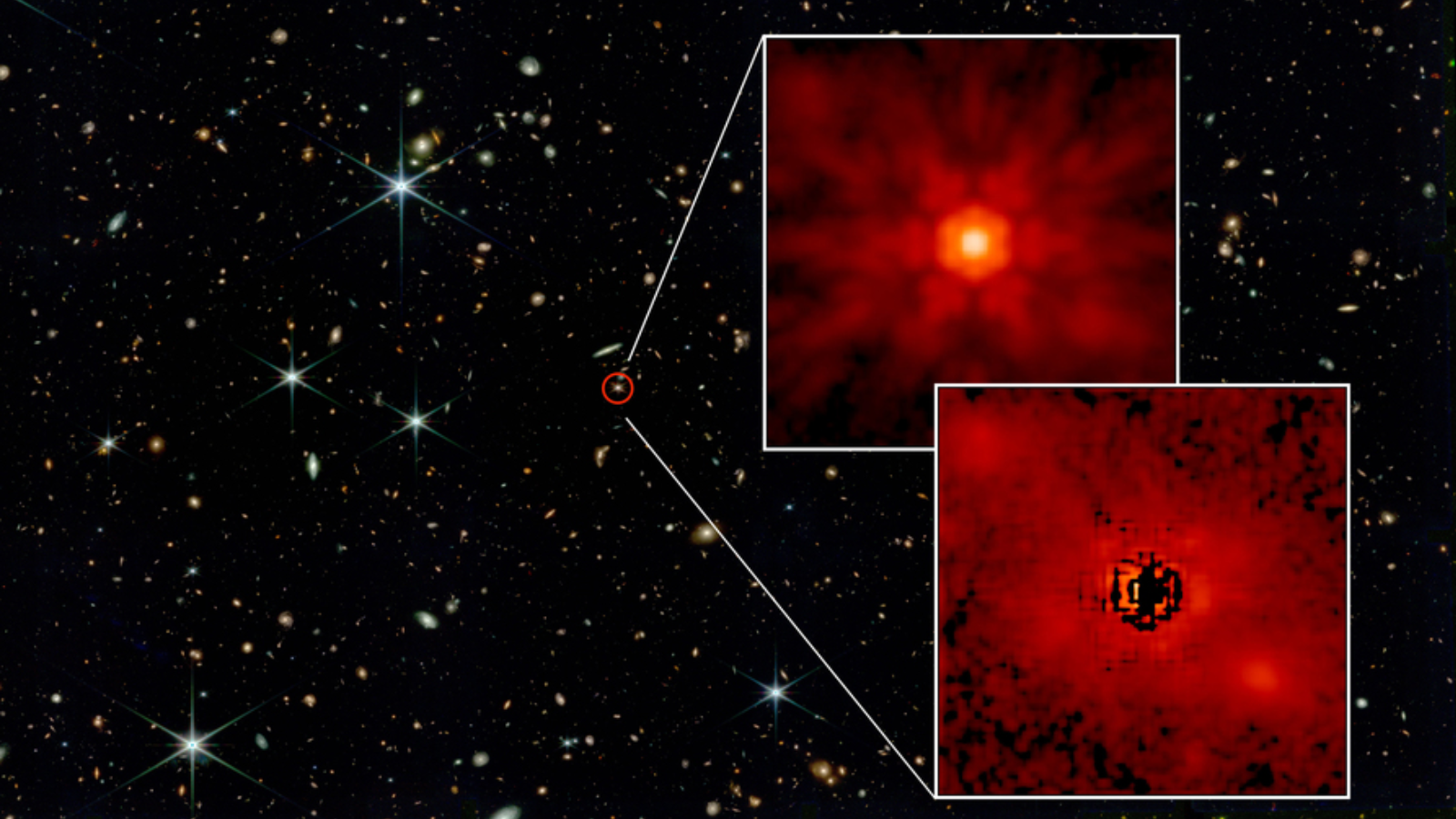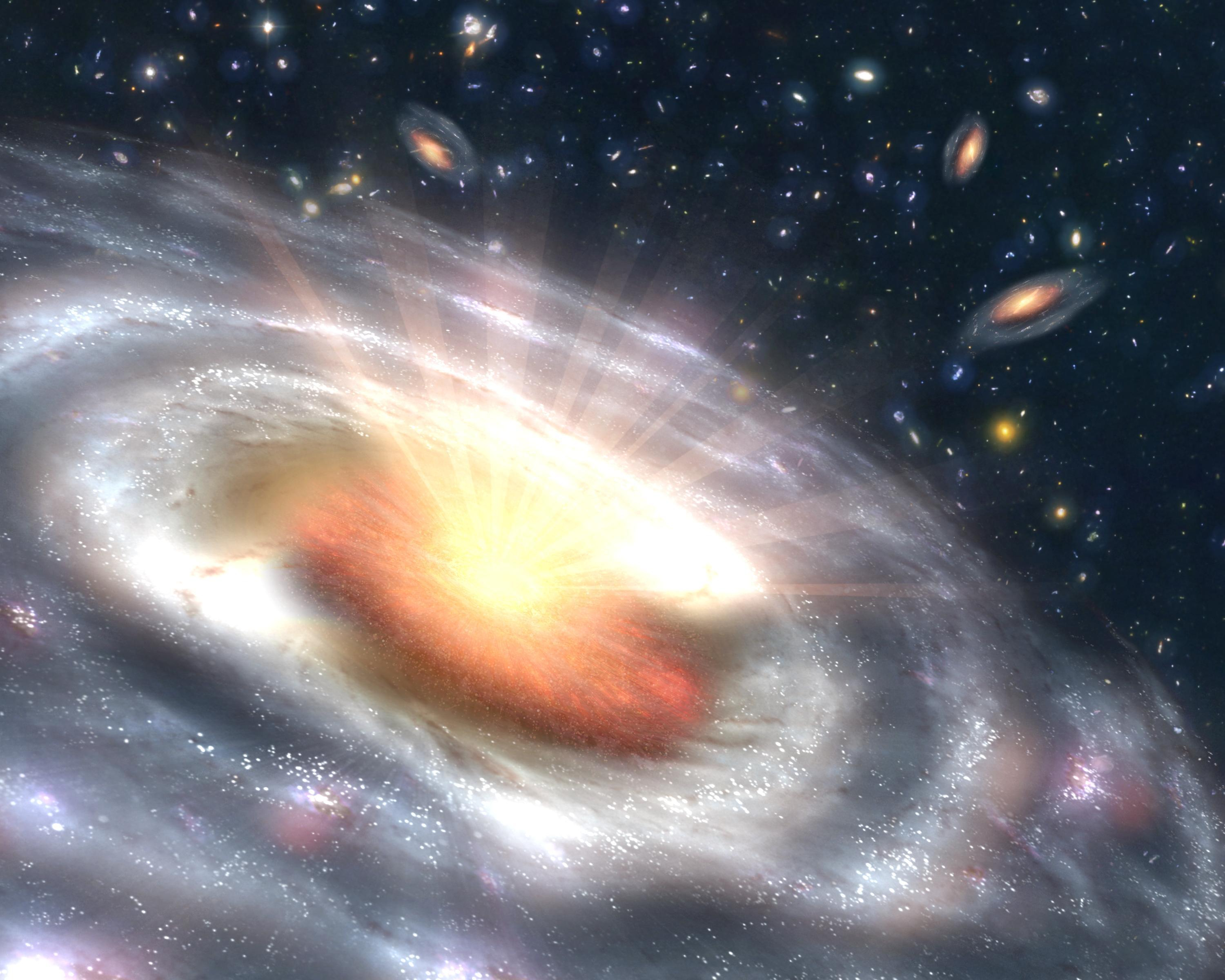
The James Webb Space Telescope (JWST) has observed light from stars surrounding some of the earlier supermassive black holes in the universe — black holes seen as they were less than a billion years after the Big Bang.
The observations conducted by a team from the Massachusetts Institute of Technology (MIT) addresses the question of how these cosmic titans that sit at the hearts of galaxies grew to tremendous masses, equivalent to millions (sometimes even billions) of suns. More specifically, how did they grow so rapidly? The findings could also answer the riddle: What came first, the galaxy or the supermassive black hole?
The supermassive black holes observed by the MIT team are insatiably feeding on surrounding material, generating immense tidal forces in a disk of matter called an accretion disk, thereby causing the disk itself to glow. This feeding situation powers objects called quasars, which sits at the hearts of active galaxies. Quasars are among the most luminous objects in the cosmos, with some so bright they outshine the combined light of every star in the galaxies around them.
Supermassive black holes are surrounded by mystery, too — especially when seen earlier than 1 billion years in the 13.8 billion-year history of the universe. That is because the continuous merger process of black holes, by which scientists think supermassive black holes grow over time, should take many billions of years to proceed. So, how could these giant voids exist only about 1 billion years after the Big Bang?
Well, one suggestion is that they got a head start, forming from so-called "heavy seed" black holes.
By using the JWST to observe faint light coming from stars in the host galaxies of six ancient quasars, the MIT team has, for the first time, collected evidence that supermassive black holes in the early universe indeed grew from heavy seeds.
"These black holes are billions of times more massive than the sun, at a time when the universe is still in its infancy," Anna-Christina Eilers, team member and assistant professor of physics at MIT, said in a statement. "Our results imply that in the early universe, supermassive black holes might have gained their mass before their host galaxies did, and the initial black hole seeds could have been more massive than today."
What came first? The black hole or its galaxy?
Discovered in the 1960s, the intense brightness of quasars was initially believed to originate from a single, star-like point. This led to the name "quasar," which is a portmanteau of the term "quasi-stellar" object. Researchers soon found, however, that quasars are actually caused by vast amounts of matter getting accreted to supermassive black holes at the hearts of galaxies.
However, these objects are also surrounded by stars, which are much fainter and more difficult to observe. That is because this stellar light is washed out by the brighter light of the quasar the stars orbit. Thus, separating out light from quasars and light from stars around them is no mean feat, akin to seeing the light of fireflies sitting on the lamp of a lighthouse around a mile away.
The JWST's ability to peer further back in time than any prior telescope, coupled with its high sensitivity and resolution, has made this challenge less daunting, however. Thus, the MIT team managed to observe light that has been traveling to Earth for around 13 billion years from six quasars in ancient galaxies.
"The quasar outshines its host galaxy by orders of magnitude. And previous images were not sharp enough to distinguish what the host galaxy with all its stars looks like," team member Minghao Yue, a postdoc at MIT's Kavli Institute for Astrophysics and Space Research, said. "Now, for the first time, we are able to reveal the light from these stars by very carefully modeling JWST's much sharper images of those quasars."

The JWST data included measurements of each of the six quasars' light emissions across a range of wavelengths. This information was then introduced to a computer model detailing how much of this light could be attributed to a compact point source — the accretion disk around the black hole — and how much can be attributed to a more diffuse source — the stars scattered around the galaxy.
By splitting the light into two sources, the team was also able to infer the mass of both elements of these galaxies. This revealed that the supermassive black holes have masses equal to around 10% of the masses of the stars around them.
While this might sound like a massive imbalance in favor of the stars, consider how in modern galaxies, central supermassive black holes have masses merely 0.1% that of the stars in their surrounding galaxies.
"This tells us something about what grows first: Is it the black hole that grows first, and then the galaxy catches up? Or is it the galaxy and its stars that first grow, and they dominate and regulate the black hole’s growth?" Eilers said. "We see that black holes in the early universe seem to be growing faster than their host galaxies.
"That is tentative evidence that the initial black hole seeds could have been more massive back then."
"After the universe came into existence, there were seed black holes that then consumed material and grew in a very short time. One of the big questions is to understand how those monster black holes could grow so big, so fast," Yue concluded. "There must have been some mechanism to make a black hole gain their mass earlier than their host galaxy in those first billion years.
"It's kind of the first evidence we see for this, which is exciting."
The team's results are published in the Astrophysical Journal.







